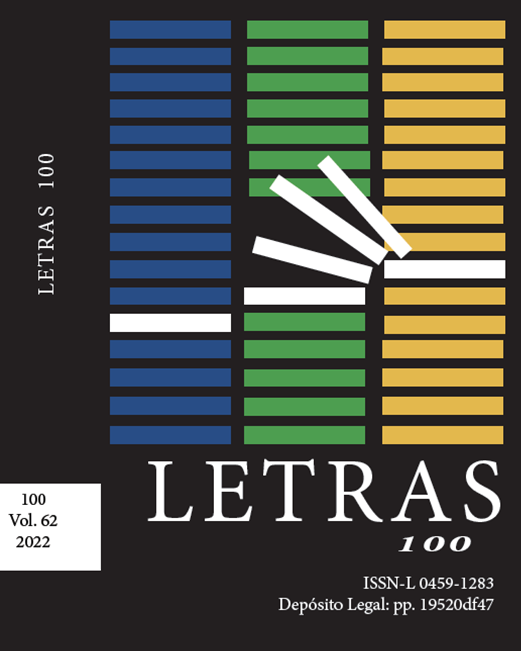The roundtable conversation: a practice that is built from interaction
DOI:
https://doi.org/10.56219/letras.v62i100.1417Keywords:
roundtable conversation, face-to-face discourse, question-answer pair, power relations, critical thinkingAbstract
This article was based on the study of the roundtable conversation as one of the manifestations of face-to-face discourse. In light of this, the objective of this work is to establish the importance of the question-answer pair in the power relationships that develop in the roundtable conversation as a formal class face-to-face practice. The theoretical framework was supported by Martínez (2001), Gallardo (1998), Tuson Valls (1997), Cazden (1991) and Halliday (1982). This research was qualitative, with a phenomenological orientation, complemented with a critical discourse analysis. The methodology is based on Martinez (2009), Taylor and Bodgan (2000) and Focault (1996), supported by Fairclough (1986). The conclusions pointed to a roundtable conversation with a strong influence of teacher-student power relationships which direct the roundtable conversation towards the perception of the teacher as a pedagogue, a builder of critical thinking of both the teacher and student.
Downloads
References
Cabrera Cuevas (2003). Discurso docente en el aula. Estudios Pedagógicos. Revista Estudios Pedagógicos [online]. No. 29.Pp.7-26, DOI: https://doi.org/10.4067/S0718-07052003000100001
https://www.redalyc.org/pdf/1735/173514130001.pdf.
Camacaro, Z (2003). El aula de clase: contexto para la elaboración de la imagen. La Revista Venezolana de Educación (Educere) [online]. vol.9, n.30. Pp.311-316, http://com.ve.scielo.org/scielo.php?script=sci_abstract&pid=S1316-102005000300005&lng=es&nrm=iso.
Calsamiglia, H y Tuson, A (2007). Las cosas del decir: Manual de análisis del discurso. Barcelona: Arial.
Cazden, C (1991). El discurso en el aula: El lenguaje de la enseñanza y del aprendizaje. Madrid. Edic. Paidós.
Cros, A (2003). Convencer en clase: Argumentación y discurso docente. Barcelona: Arial.
Charadeau, P y Maingueneau, D (2005). Diccionario de análisis del discurso. Buenos Aires: Amorrortu.
Chafe, W (1974). Lenguaje y conciencia. Rev. Lenguaje.Vol 01.No.50. Chicago. University Chicago Press.
Domínguez, C (2005). Sintaxis de la lengua oral. Boletín de Lingüística.vol.30.no.20. pp.11-17.
http://ve.scielo.org/scielo.php?script=sci_arttext&pid=S0798-97092008000200008.
Fairclough, N (1989). Language and Power. Londres. Longman.
Fernández. B, P y Melero. Z, M (1995). La interacción social en contextos educativos. España: Siglo. XXI.
Gallardo, B (1998). Comentario de textos conversacionales. Madrid: Arco/Libros. S.A.
Halliday, M (1982). El lenguaje como semiótica social. México: F.C.E.
León, A (1998). Estructura y administración de la docencia de pregrado: Elementos característicos del trabajo docente. Educere, [online] no.23. Pp.377-386. https://www.redalyc.org/pdf/356/35602309.pdf.
León, A (2007). ¿Qué es la educación? Interacción verbal en el aula de clases. Educere, [online]. vol.11, no.39. pp.595-604. http://ve.scielo.org/scielo.php?pid=S1316-49102007000400003&script=sci_abstract.
Obando, Lucila (2000). Interacción verbal y procesos pedagógicos. Revista Enunciación, [online], vol. no. 4-5. pp.119-122. DOI: https://doi.org/10.14483/22486798.2542
https://revistas.udistrital.edu.co/index.php/enunc/article/view/2542.
Martínez, M (2009). Ciencia y arte de la metodología cualitativa: Métodos hermenéuticos, métodos fenomenológicos y métodos etnográficos. México: Trillas. DOI: https://doi.org/10.15332/s0120-8454.2009.0074.03
Martínez, M. (2000). El paradigma emergente: Hacia una teoría de la racionalidad científica. México: Trillas.
Martínez, M.C. (2001). Análisis del discurso y prácticas pedagógicas: Una propuesta para leer, escribir y aprender mejor. Santafé, Argentina: Homosapiens.
Moratella, T.D (2007). Paul Ricoeur, una filosofía para la educación. La ética hermenéutica Aplicada a la educación.pp.2-28.
https://dialnet.unirioja.es/servlet/articulo?codigo=6598891.
Morín, E (1984). Ciencia con conciencia. Barcelona: Anthropos.
Penzias, A (1992). Comunicación: Un espacio para discutir. Madrid: Siglo XXI.
Taylor, S.J. y Bogdan, R (2000). Introducción a los métodos cualitativos de las investigaciones. Barcelona: Paidós.
Tuson Valls, A (1997). Análisis de la conversación. Barcelona: Ariel.
Van Dijk, A. T (2009): Discurso y poder. Barcelona: Gedisa.
Published
How to Cite
Issue
Section
License
Copyright (c) 2022 Letras

This work is licensed under a Creative Commons Attribution-NonCommercial-ShareAlike 4.0 International License.
Letras magazine retains the patrimonial rights (copyright) of the published works, which favors and allows their reuse under the license (CC BY - NC - SA 4.0), for which they can be copied, used, disseminated, transmitted and expose publicly, as long as the authorship and original source of its publication (magazine, publisher, URL and DOI of the work) is cited, they are not used for commercial or onerous purposes and the existence and specifications of this use license are mentioned.















